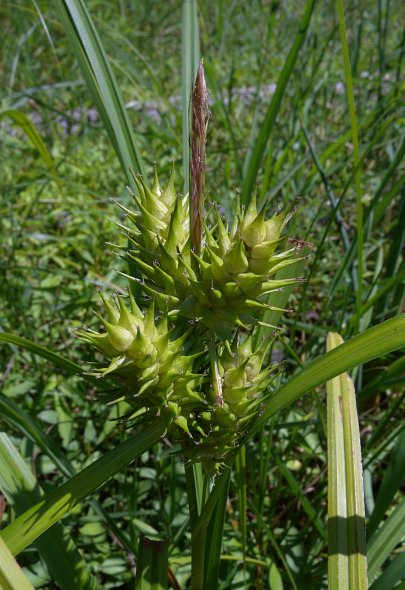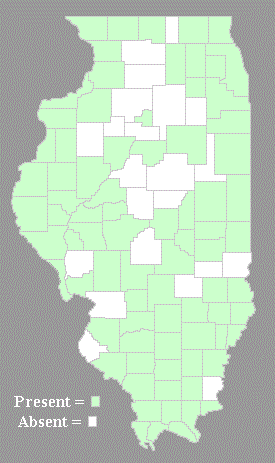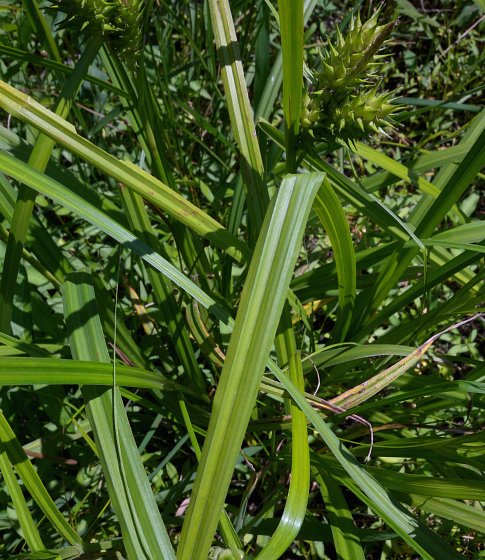
Each culm terminates in an inflorescence about 3-12" (10-30 cm.) long that consists of 2-5 pistillate spikelets, a single staminate spikelet (rarely there are 2-3 staminate spikelets), and their leafy bracts. The large pistillate spikelets are 1-2.5" (2.5-6.5 cm.) long and ¾-1" (2-2.5 cm.) across, consisting of densely packed perigynia and their scales that are ascending and facing all directions. The long beaks of these perigynia provide the pistillate spikelets with a spiky appearance. The perigynia are 10-17 mm. long and 3-4.5 mm. across; they are lanceoloid to ovoid, light green to brownish yellow, glabrous, and inflated; along their sides are numerous longitudinal veins (typically 18-22). The perigynia have rounded bases and long slender beaks that terminate in a pair of short teeth (up to 2 mm. in length). The pistillate scales are shorter than the perigynia and lanceolate in shape; they have central green veins and broad membranous margins. The floret of each perigynia has a single long style that is curled or curved, and there are 3 stigmata. The pistillate spikelets are erect to ascending; they have peduncles that can vary in length from 1/8" (3 mm.) to 6" (15 cm.), although they are usually less than 2" (5 cm.) in length. The terminal staminate spikelet is ¾-3½" (2-9 cm.) long and 2-4 mm. across; this slender spikelet is held erect on a peduncle that is variable in length and it soon turns brown after the blooming period. The leafy bracts of the spikelets are up to 12" (30 cm.) long and 9 mm. across; they are similar to the leaf blades and usually overtop the inflorescence. The blooming period occurs from late spring to mid-summer, lasting about 1-2 weeks. The florets are cross-pollinated by the wind. Afterwards, the achene-bearing perigynia become brownish yellow and disarticulate from
 their spikelets. They are
distributed in part by wind or water. Individual achenes are 3-4 mm.
long and 1.5-2.5 mm. across; they are hexaploid-rhomboid in shape (like
a 6-sided polygon that is diamond-shaped), but noticeably flattened
along
one axis, and glabrous. The root system
is fibrous and rhizomatous.
their spikelets. They are
distributed in part by wind or water. Individual achenes are 3-4 mm.
long and 1.5-2.5 mm. across; they are hexaploid-rhomboid in shape (like
a 6-sided polygon that is diamond-shaped), but noticeably flattened
along
one axis, and glabrous. The root system
is fibrous and rhizomatous.Cultivation: The preference is full sun to light shade, wet to moist conditions, and soil consisting of loam, clay-loam, silty loam, or sandy loam, and some decaying organic material. Occasional inundation by slow-moving or stagnant water is readily tolerated.
Range & Habitat: The native Hop Sedge is occasional throughout Illinois. Habitats include wet prairies, prairie swales, wet meadows along rivers, low areas along ponds and lakes, typical swamps and sandy swamps, openings in bottomland woodlands, shallow vernal pools, degraded seasonal wetlands, and ditches. This robust sedge can be found in a variety of wetlands, although it tends to be most common in areas with partial shade. This sedge is sometimes cultivated in gardens and it is often used in wetland restorations.
Faunal Associations: A variety of wildlife use sedges (Carex spp.) as a source of food and cover. Insects that feed on Hop Sedge and other wetland sedges include aquatic leaf beetles (especially Plateumaris spp.), Sphenophorus costicollis (Sedge Billbug), various aphids (Rhopalosiphum spp., Thripsaphis spp., etc.), various leafhoppers (especially Cosmotettix spp.), the seedbugs Cymus angustatus and Oedancala dorsalis, the stem-boring larvae of such flies as Cordilura varipes and Loxocera cylindrica, the caterpillars of various skippers (especially Euphyes spp.), caterpillars of the butterflies Satyrodes appalachia (Appalachian Brown) and Satyrodes eurydice (Eyed Brown), caterpillars of such moths as Amphipoea americana (American Ear Moth) and Hypocoena inquinata (Tufted Sedge Moth), and sedge grasshoppers (Stethophyma spp.); see the Insect Table for a more complete listing of these species. These insects in turn are eaten by insectivorous birds, frogs, snakes, and other wildlife. The seeds of wetland sedges are an important source of food to various birds, including coots, ducks, rails, gamebirds, and granivorous songbirds (see Bird Table). White-Tailed Deer browse on the foliage of these plants sparingly as they prefer broad-leaved plants (dicots). Wetland sedges are also a minor source of food to some turtles, including Chelydra serpentina (Snapping Turtle) and Kinosternum subrubrum (Eastern Mud Turtle).
Photographic Location: A seasonal wetland at Judge Webber Park in Urbana, Illinois.

Comments: Hop Sedge is one of the larger and more showy sedges. Because of its large prickly pistillate spikelets and unusually large perigynia, it is relatively easy to distinguish this species from other sedges (Carex spp.). An exception is the uncommon Hop-like Sedge (Carex lupuliformis), which has a very similar appearance and can be found in similar wetland habitats. Hop-like Sedge has achenes that are hexaploid-rhomboid in shape (like a 6-sided polygon that is diamond-shaped), but they are not flattened along any axis, unlike the achenes of Hop Sedge (Carex lupulina). Another difference, although this is not always reliable, is the tendency of Hop-like Sedge to produce more staminate spikelets on each culm (often 2-3), whereas Hop Sedge almost always produces only a single staminate spikelet per culm. Hybrid plants between these two species are possible, therefore some specimens in the field may display intermediate characteristics that may cause difficulties in their classification. Hop Sedge has also been known to form sterile hybrid plants with Carex lurida (Sallow Sedge) and one or two other species of wetland sedge.